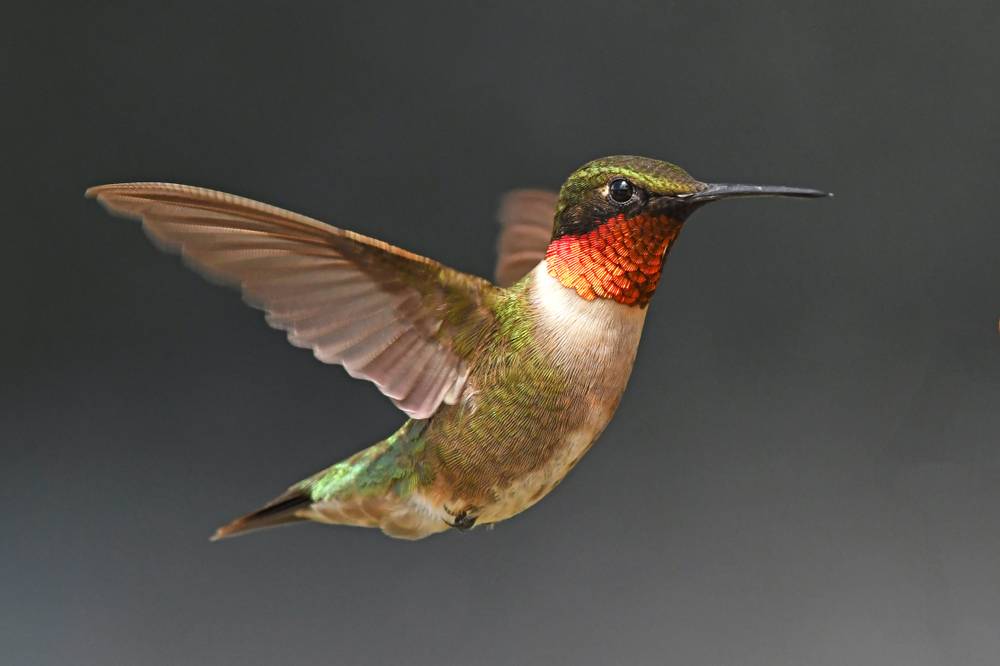Hummingbirds are amazing little creatures, capable of flying in ways that no other bird can. If you’ve ever watched a hummingbird flitting around some flowers and wondered, “how do hummingbirds fly?” this article is here to answer that question.
So, how do hummingbirds Fly? Hummingbirds fly by using their unique physiology to rotate their wings mid-flight, which allows them to quickly change direction and hover indefinitely. In many ways, their flight style has more in common with insects like dragonflies than with other birds, but they’ve managed to adapt that insect-like flight to a vertebrate body.
Unique Flight Techniques
Most birds rely on their downstrokes to achieve most of their lift, while the upstrokes don’t do much other than resetting the wing position for another downstroke.
Because of this, most birds can only fly forward, and can’t change directions very quickly.
Hummingbirds, however, have evolved to use their wings more like an insect does, able to quickly change direction by making small adjustments to the angle of their wings.
Rather than flapping their wings up and down, they “row” their wings back and forth rapidly, tilting them up to 180 degrees at the wrist so that they can catch the air on both the forward and backward strokes.
Combine that ability to rotate their wings so dramatically and the fact that smaller hummingbirds can flap their wings at a rate faster than any other bird species, and that’s why hummingbirds can do all the unique acrobatic techniques we observe.
Physiological Differences Between Hummingbirds and Other Birds
Why do hummingbirds use their wings so differently from the way other birds do?
A lot of it comes down to how their bodies are built. A typical bird can’t rotate its wings to achieve lift in all directions because its shoulder muscles just aren’t able to move that way.
Hummingbirds have found a way to invert their wings by twisting their wrists with each flap, changing the shape of the whole wing.
Other physiological differences include:

Larger pectoral muscles
A hummingbird’s pectoral (chest) muscles, which control wing movement, make up around 25% of the bird’s entire body weight, compared to an average of around 17% for most other bird species.
Weak feet
A hummingbird’s feet are good for perching and small movements, but they cannot walk.
This is because they spend most of their time in the air, and they’ve evolved to reduce weight by developing weak feet.
A large heart
Hummingbirds need to be able to move fast to keep in the air, and to support those fast movements, their heart is larger and beats faster than any other bird species.
Even at rest, a hummingbird’s heart rate is over 200 beats per minute, and at its fastest, it reaches more than 1200 beats per minute.
For reference, the average human heart rate is 60-100 beats per minute when at rest.
Hummingbirds Flight
Hummingbirds have a great flight ability and therefore, they can fly backward, forward, straight up as well as sideways.
They also hover much more than other birds.
The ornithologists have researched on their flight for decades and with the help of using technologies to analyze air currents.
The study on the wings of hummingbirds has provided a lot of data to scientists on how hummingbirds fly.
Scientists are still working to learn more about how hummingbirds manage to achieve these amazing feats of flight, but for now, we bird lovers can just sit back and enjoy the beauty of it.
Bonus- Facts on Hummingbirds flight Abilities
- Generally, a hummingbird beats its wing 8-25 times per second. This is due to the low surface area of their wings. Even while a hummingbird is diving their wings beating speed is higher than other birds.
- They have the ability to fly at a speed of upto 60 miles per hour. During a steady flight you will see an average speed of 20-45 miles per hour.
- A hummingbird waste most of its time just hovering over to their feed.
- Hummingbird is the only bird that can fly backwards. The high speed of beating wings burns a lot of calorie and therefore they need high calorie sugar water solution which gives them enough energy to keep flying.
Conclusion
Hummingbirds beat their wings faster than many other birds and therefore they need sugar and water nectar which provide energy to them.
Providing a resting place for the hummingbirds by hanging hummingbird feeders or planting flowers in your backyard or garden would help hummingbirds keep visiting you.
By just understanding how hummingbirds fly, you can exactly understand what amount of nectar you need daily and why you should keep clean hummingbirds feeder.
Related Questions
How do hummingbirds wings work? Hummingbirds wings work a bit different from general birds and you would find their wings working much like a buzzing insect than a normal bird.
How do hummingbirds fly so fast? Hummingbirds have to use its flight muscle at a high speed to stay aloft in air. They lose a lot of muscle power during their flight.


